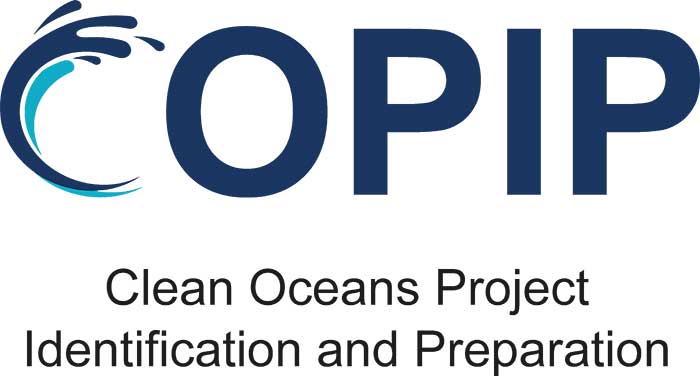The problem of plastic pollution
Global production of plastics increased nearly 200 – fold between 1950 and 2015[1]. It is projected that the import of plastics in some African countries will double by 2030 and close to 165 million tonnes of plastics will reach their end of life in African countries in the next decade[2]. In the absence proper infrastructure, technology or tools to track and manage plastics, pollution will outpace efforts to prevent it and countless quantities of plastics will be discharged to the oceans causing a potential threat to food security, environmental sustainability and economic development. Currently, close to 8 million tonnes[3] of plastics and 1.5 million tonnes[4] of micro plastics are discharged to the oceans every year primarily from coastal or riverine cities with limited waste and wastewater collection and no or substandard systems of waste disposal and wastewater treatment.
The proposed approach to reduce plastic pollution
COPIP is supporting coastal cities in more than 25 countries in the sub-Saharan Africa to identify, assess and prepare for implementation solid waste, wastewater, and storm water management projects with emphasis on a circular economy approach to plastics. COPIP projects are based on a balanced approach considering the sustainable development goals (SDGs), specific country policies, economy, investment gaps, climate change, and potential for expansion in the sub-Saharan Africa. Equally, COPIP team acknowledges that voluntary agreements and policies alone cannot reach the scale needed to urgently solve marine litter crisis. Therefore, the team is looking to amplify existing efforts and propose innovative ideas to deliver industry scale solutions in the waste management sector with special emphasis on the following;
- Establishing and expanding infrastructure for separate collection of wastes.
- Supporting adoption of alternative packaging materials through redesign, innovation, and delivery of eco-friendly models to eliminate problematic or unnecessary plastics.
- Promoting reuse and recycling models to reduce need for single use plastics.
Impact of COPIP programme
The COPIP team will identify a pipeline of 20 projects in Sub- Saharan Africa, with five projects prepared including Terms of Reference for project implementation support. So far, projects in Kenya, Gabon, Tanzania and Gambia are at an advanced stage of preparation. Specifically, Tanzania project titled Towards Zero Waste Model Town Tanga City is an ambitious proposal to implement several circular economy solutions to waste management and propel the city to a near zero waste society. It is expected that upon successful implementation of the project, Tanga City will become a frontrunner that various cities and towns will emulate concerning adoption of zero waste principles. In addition, COPIP is proposing additional components in all their projects such as fusion of solar energy generation and waste management through installation of photovoltaic panels on Material Recovery Facilities (MRFs). This could boost efforts to meet energy demands for operations of waste management equipment.
In view of this, COPIP team is laying the foundations for a coordinated and wide-reaching cooperation between various actors in the countries of focus. This is needed to ensure behavior change across plastic value chains and to influence people to embrace circularity. It is manifest that planning for and investing in circular economy systems, specifically for municipal waste could help countries in the sub-Saharan Africa to create decent job opportunities for the population, curtail resource depletion, enhance resilience to climate change impacts and curb future health problems that arise from poor waste management practices.
Compiled by: Joanes Odero
[1] The Ellen MacArthur Foundation (link)
[2] Ibid
[3] “Plastic waste inputs from land into the ocean.” Jambeck, Jenna, et al. Science 347, no. 6223, 2015 (link)
[4] “Primary microplastics in the oceans: A global evaluation of sources,” Boucher, Julien, and Damien Friot. International Union for Conservation of Nature, Gland, Switzerland, 2017. (link).


